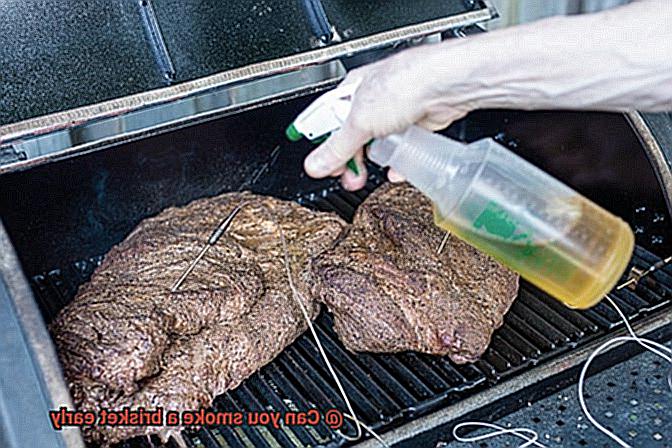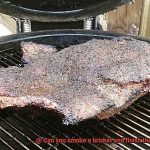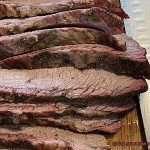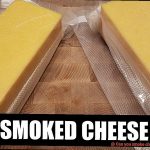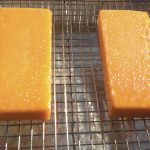Who doesn’t salivate at the thought of a perfectly cooked, juicy brisket? The kind that’s so tender it falls apart as soon as it’s sliced, and is packed with smoky flavor that just melts in your mouth. But let’s face it, brisket takes time – a lot of time. And sometimes, you just don’t have that luxury. So, what if we told you that you could smoke your brisket early? Yes, you read that right – you can actually smoke a brisket early.
If you’re a seasoned pitmaster, then you know smoking a brisket is an elaborate process that can take anywhere between 12 to 16 hours, depending on the size of the cut and the temperature. But what if we told you there’s an alternative option where you can still achieve that delicious smoky flavor by smoking it a few hours before serving? Well, guess what? You absolutely can.
In this blog post, we’re going to delve into the question “Can you smoke a brisket early?” We’ll cover all the basics of smoking brisket including optimal temperature and timing before exploring whether or not smoking it early is a viable option. Additionally, we’ll share some tips and tricks for smoking brisket ahead of time so that even when pressed for time, your guests will still be blown away by your mouth-watering brisket. So sit back and get ready to learn how to master this culinary art.
Contents
Can You Smoke a Brisket Early?
Smoking a brisket is a revered culinary art form that requires patience, skill, and attention to detail. But what happens when life gets in the way and you need to smoke your brisket early? Can it be done without sacrificing flavor and tenderness? The answer is yes, but with some caveats.
Pros of Smoking a Brisket Early:
- Time saver: Smoking a brisket early can be a lifesaver if you have a tight schedule and need to prepare the meat ahead of time. This can help you save time and effort when it comes to meal prep.
- Moisture retention: Wrapping the brisket in foil or butcher paper after smoking it helps to retain moisture and prevent the meat from drying out. This ensures that your brisket stays juicy and flavorful.
- Connective tissue breakdown: Smoking the brisket at a low temperature for a longer period of time helps to break down the connective tissue and fat in the meat. This results in tender, succulent brisket that everyone will love.
Cons of Smoking a Brisket Early:
- Risk of dryness: Smoking a brisket too far in advance can result in dry, tough meat that lacks tenderness and flavor. It’s important to keep an eye on the timing and temperature to ensure that your brisket is cooked safely and to your liking.
- Sacrifice of traditional smoky flavor: Using the “Texas Crutch” method may take away from the traditional smoky flavor of a brisket cooked solely on a grill or smoker. Purists may argue against this method.
- Adjustments needed: Smoking a brisket early may require adjustments in cooking time and temperature to ensure that it is cooked properly. This can take some trial and error to get right.
One option for smoking a brisket early is to use the “Texas Crutch” method, which involves wrapping the brisket in foil or butcher paper after a few hours of smoking and finishing it in an oven at a low temperature until it reaches the desired internal temperature. This method can help speed up the cooking process and also prevent the brisket from drying out.
However, some purists may argue that this method takes away from the traditional smoky flavor of a brisket cooked solely on a grill or smoker. It’s important to note that smoking a brisket early may also require some adjustments in cooking time and temperature to ensure that it is cooked properly.
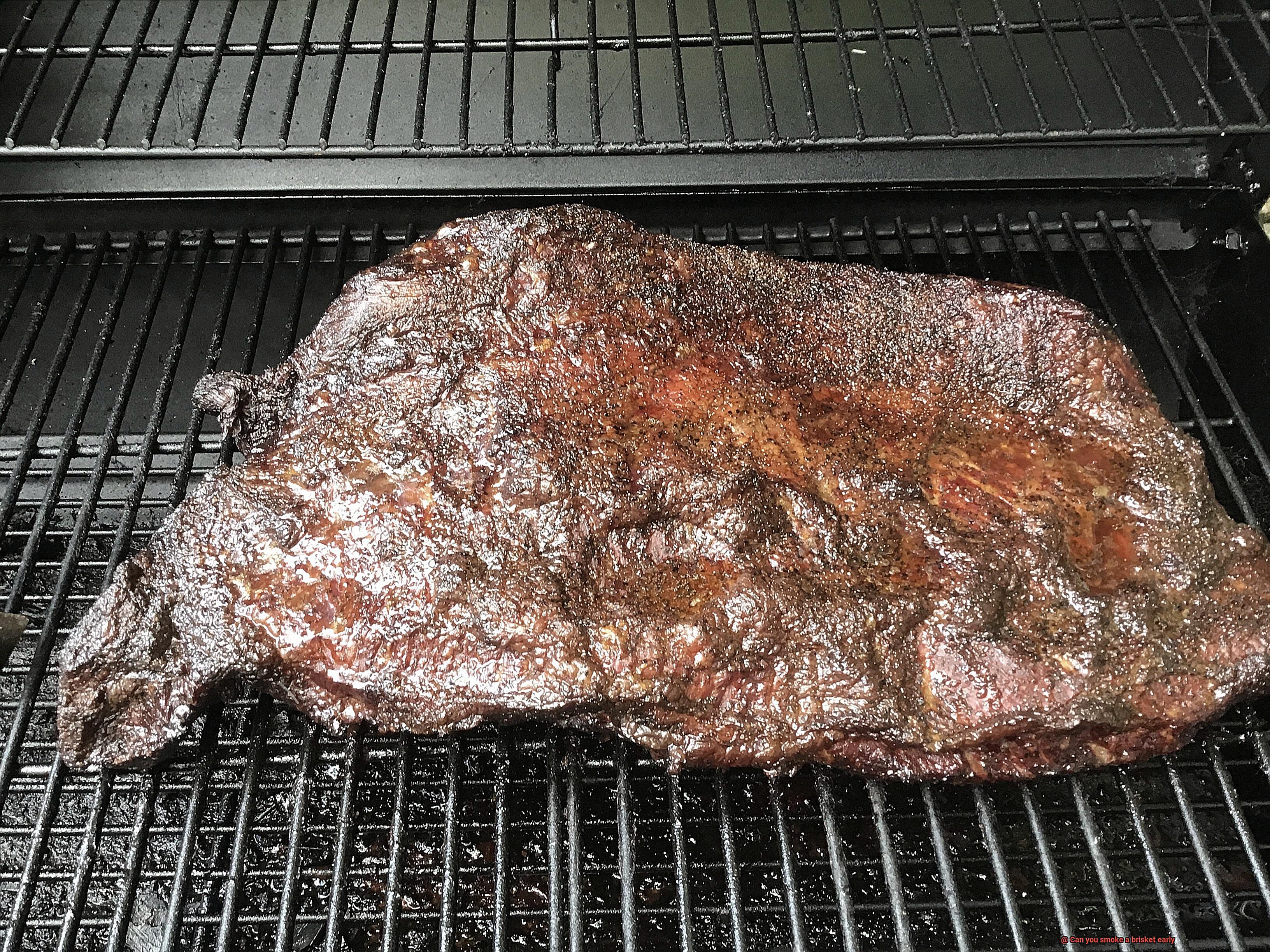
Benefits of Smoking a Brisket Early
This technique has gained popularity among BBQ aficionados for good reason – it can make the difference between a mediocre and an outstanding brisket. Let’s explore the benefits of smoking a brisket early and why you should give it a try.
Firstly, smoking a brisket early allows for maximum flavor infusion. You have ample time to apply your favorite rubs and spices to the meat before it hits the grill. This extra time gives the meat a chance to soak up all those delicious flavors, resulting in a more flavorful and succulent brisket that will leave your taste buds dancing with delight.
But that’s not all. Smoking a brisket early also offers better control over the cooking process. With more time to monitor and adjust the temperature of your grill or smoker, you’ll be able to ensure that the meat cooks evenly without being overcooked or undercooked. The result? A juicy and tender brisket that will melt in your mouth.
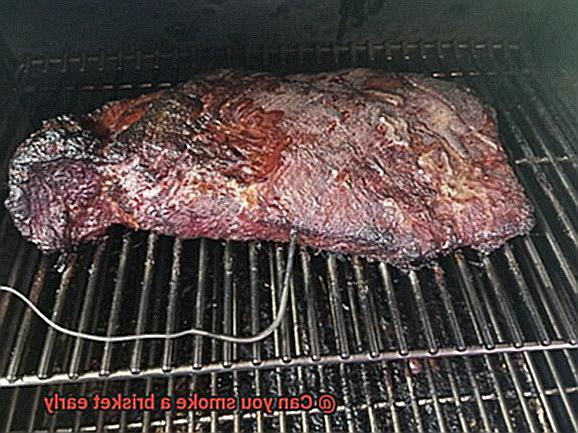
In addition to better control, smoking a brisket early also provides more flexibility with your cooking schedule. By finishing the cooking process well ahead of time, you can free up your schedule to prepare side dishes or attend to other tasks. And if unexpected guests arrive or dinner plans change, you can simply reheat the brisket without sacrificing its flavor or texture.
Potential Drawbacks of Smoking a Brisket Early
Smoking a brisket early may seem like a tempting option, but there are potential drawbacks that must be considered. As an expert on brisket smoking, let me guide you through the potential pitfalls.
Firstly, smoking a brisket too early can lead to dryness. Brisket is a tough cut of meat that requires a long cooking process to break down the collagen and connective tissue. If you smoke it too early and let it sit for too long, it can end up dry and unappetizing. To avoid this, aim to smoke your brisket as close to serving time as possible.
In addition to dryness, there are food safety concerns to consider. Leaving meat at room temperature for too long can allow harmful bacteria to multiply, increasing the risk of foodborne illness. While smoking the brisket will help kill off some of the bacteria, it’s essential to monitor the internal temperature and ensure that it reaches a safe level before serving.
Lastly, smoking a brisket early can impact the flavor profile of the meat. As it sits in its juices and cools down, it can absorb more smoke than intended, resulting in an overpowering smoky flavor. Moreover, reheating the brisket later on may result in a loss of flavor and texture.
To summarize, here are some potential drawbacks to smoking a brisket early:
- Dryness
- Food safety concerns
- Changes in flavor profile
Preparing the Brisket for Smoking
The key to success lies in the preparation of your meat. As a self-proclaimed expert, I’ve gathered some essential tips and tricks to ensure your brisket is the talk of the town.
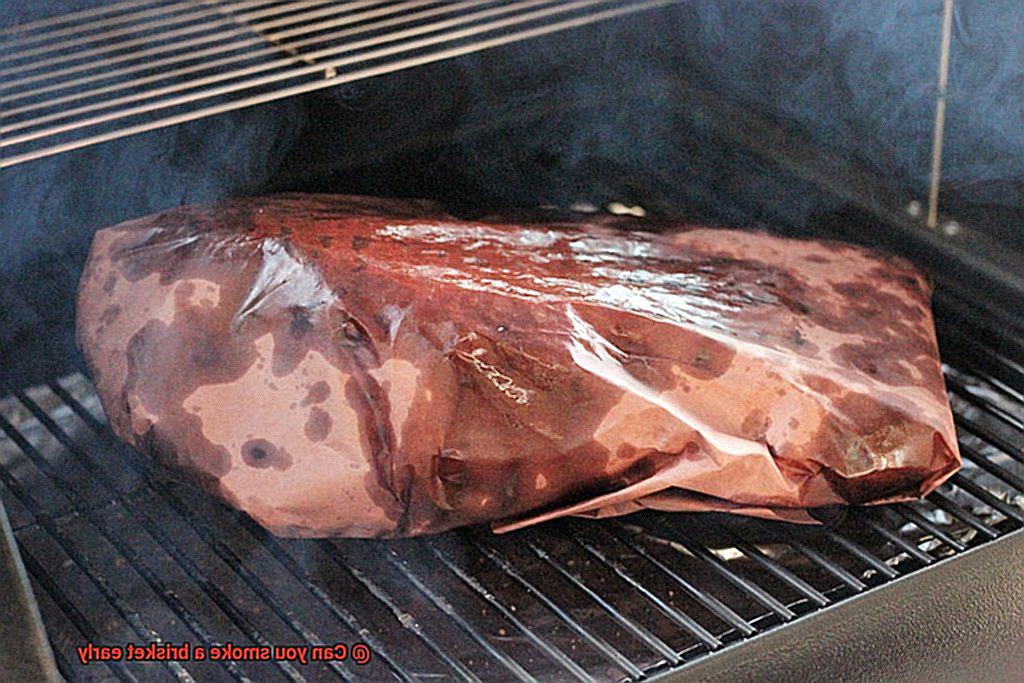
Firstly, make sure to properly trim your brisket. Remove any excess fat, gristle or hard portions. This not only improves the taste but also ensures even cooking and tenderness.
Next, the seasoning is crucial in creating a flavorful brisket. While some pitmasters prefer simple salt and black pepper rubs, don’t be afraid to experiment with seasonings such as garlic powder, onion powder, paprika, cumin, or chili powder. Once you’ve seasoned your brisket, wrap it tightly in plastic wrap and refrigerate overnight. This allows the flavors to penetrate the meat, enhancing its taste.
On the day of smoking, let the brisket come to room temperature for about an hour before placing it on your smoker. This will help prevent any temperature shocks that could affect the texture of the meat.
Now it’s time to smoke. Preheat your smoker to 225-250°F and place your brisket on the smoker fat-side up. It’s essential to maintain a consistent temperature throughout the cooking process by keeping an eye on your smoker and adjusting accordingly.
Patience is key when smoking a brisket. It can take anywhere from 10-16 hours depending on its size and thickness. Resist the temptation to peek too often or open the lid unnecessarily as this can cause fluctuations in temperature that may affect the overall quality of your brisket. Trust in the process and let your smoker work its magic.
Temperature Considerations for Smoking a Brisket Early
Getting it right requires careful consideration of the heat source, cooking time, and internal temperature to ensure safe and mouth-watering results.
Smoking a brisket typically takes between 12 and 16 hours of slow and low heat, with an ideal temperature range of 225-250°F. But if you want to smoke your brisket early, it’s crucial to take extra precautions to avoid overcooked, dry meat or potential food poisoning.
To smoke your brisket early, you have two options: partially cook it in advance or use sous-vide cooking. Partially cooking your brisket involves smoking it until it reaches an internal temperature of around 150°F, then rapidly cooling it down and storing it in the refrigerator. On the day you plan to serve it, you can finish smoking it until the internal temperature reaches the desired 200-205°F. This method allows for flexibility in timing while ensuring that the meat remains safe to eat and retains its flavor and moisture.
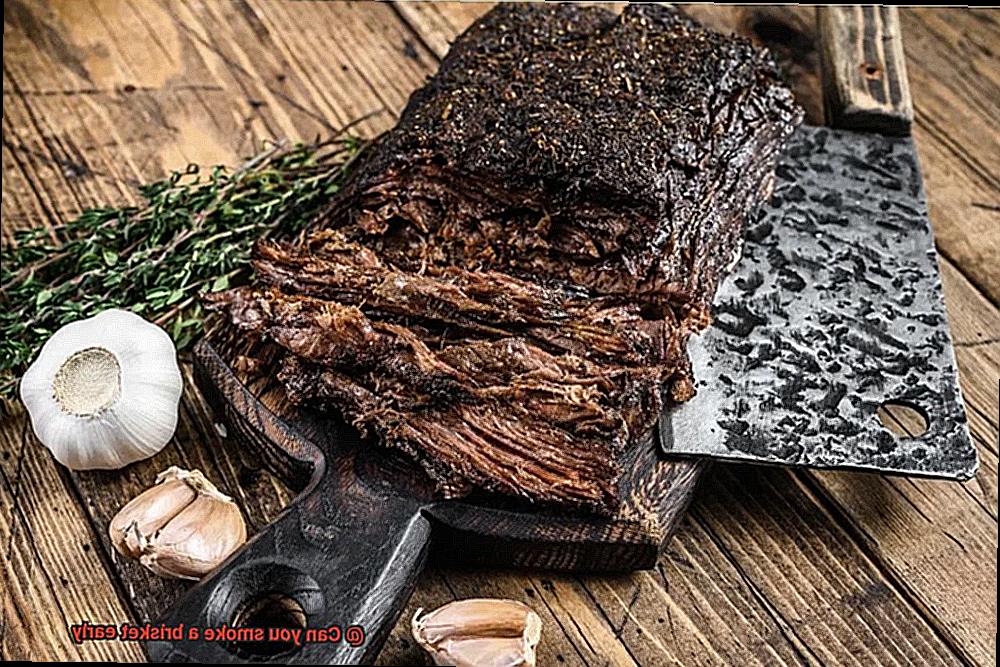
Alternatively, you can use sous-vide cooking to pre-cook your brisket before smoking. This method involves sealing the meat in a vacuum-sealed bag and immersing it in a water bath at a precise temperature for an extended period. Sous-vide cooking cooks the brisket thoroughly without overcooking or drying it out, making it perfect for smoking early.
Regardless of which method you choose, always use a meat thermometer to ensure that the internal temperature of the brisket reaches at least 145°F before serving. This guarantees that the meat is safe to eat and cooked to perfection.
Wrapping and Resting the Smoked Brisket
While you may have perfected the art of smoking the meat to perfection, achieving a succulent and luscious end product is all about wrapping and resting the smoked brisket. As an expert, I am here to enlighten you on the importance of this step and how to achieve the perfect wrap and rest for your brisket.
The reason behind wrapping and resting a smoked brisket is simple: after hours of smoking, the juices in the meat tend to concentrate towards the center. Cutting into the meat immediately after smoking could lead to a dry and tough piece of brisket. Resting allows those juices to redistribute throughout the meat, leading to a more tender and flavorful final product.
Now, let’s talk about wrapping. Wrapping helps retain moisture and prevents the brisket from drying out during the resting period. But what should you use to wrap your brisket? The choice is yours. Some pitmasters prefer foil for a tighter seal, while others opt for butcher paper or a towel for a looser wrap that still allows some airflow. Whatever your preference, ensure your wrap is tight enough to hold in moisture but not too tight that it squeezes out those precious juices.
Timing is critical when it comes to wrapping your brisket. Wrap too early, and you risk hindering the smoking process and preventing the development of that delicious bark on the outside of the meat. Wait until your brisket has reached an internal temperature of around 160-170 degrees Fahrenheit before wrapping. This typically takes several hours of smoking, depending on the size of your brisket and smoker temperature.
After wrapping, give your brisket ample time to rest. Aim for at least an hour, preferably two or more. This allows the juices to distribute evenly and for residual heat to continue cooking the brisket without drying it out. Once you’ve rested your brisket, it’s time to slice and serve.
Reheating the Smoked Brisket
As a true brisket connoisseur, you know that achieving the perfect smoked brisket is an art form. It takes time, patience, and a whole lot of love. However, what happens when you have leftovers? Don’t worry, reheating your smoked brisket can be just as delicious as the first time around if done correctly.
The best way to reheat smoked brisket is to use a slow and low method that maintains the meat’s moisture. One common mistake that people make when reheating brisket is using high heat, which can dry out the meat and make it tough. So, whether you’re using an oven, grill, or smoker, remember to keep the heat low and steady.
Here are some tips for reheating your smoked brisket to ensure it remains juicy and tender:
- Preheat your oven to 250°F and place the brisket in a baking dish. Cover it with foil and add a small amount of liquid, such as beef broth or water, to create steam. This will help keep the meat moist while reheating.
- Place the dish in the oven and reheat for 45 minutes to an hour, depending on the size of the brisket. The key is to monitor the internal temperature of the meat with a meat thermometer to ensure it has reached at least 165°F before serving.
- Alternatively, you can reheat smoked brisket on a grill or smoker. Heat your grill or smoker to 250°F and place the brisket on the grates. Cover the grill or smoker and cook for about 30 minutes or until the internal temperature of the meat reaches 165°F.
- Timing is everything when reheating smoked brisket. You want to make sure it’s heated through but not overcooked. By using slow and low heat with added moisture, you can help keep your meat moist and tender.
Tips for Successful Smoking of a Brisket Early
Smoking a brisket early can be a challenge, but with the right tips and techniques, you can still create a delicious and succulent brisket that your guests will love. Here are five sub-sections to help you achieve success when smoking a brisket early:
Plan Ahead
To ensure your brisket is cooked thoroughly and is ready to serve at the desired time, plan ahead. Start by buying a fresh brisket and marinating it overnight before the day of the event. This will help enhance the flavor and tenderness of the meat. Also, make sure you have all the necessary equipment and supplies ready, such as wood chips, charcoal, and a meat thermometer.
Choose the Right Wood
The type of wood used can make a big difference in the taste of your brisket. Some popular woods for smoking brisket include hickory, mesquite, oak, and applewood. Each wood imparts a unique flavor profile and aroma to the meat. Experiment with different woods to find the one that suits your taste preferences.
Properly Prepare Your Brisket
Before smoking your brisket, it’s important to properly prepare it. This can involve trimming the fat cap, seasoning the meat with a dry rub or marinade, and allowing it to sit in the refrigerator overnight to absorb the flavors. Trimming the fat cap will prevent flare-ups in your smoker and ensure that your brisket cooks evenly.
Maintain a Steady Temperature
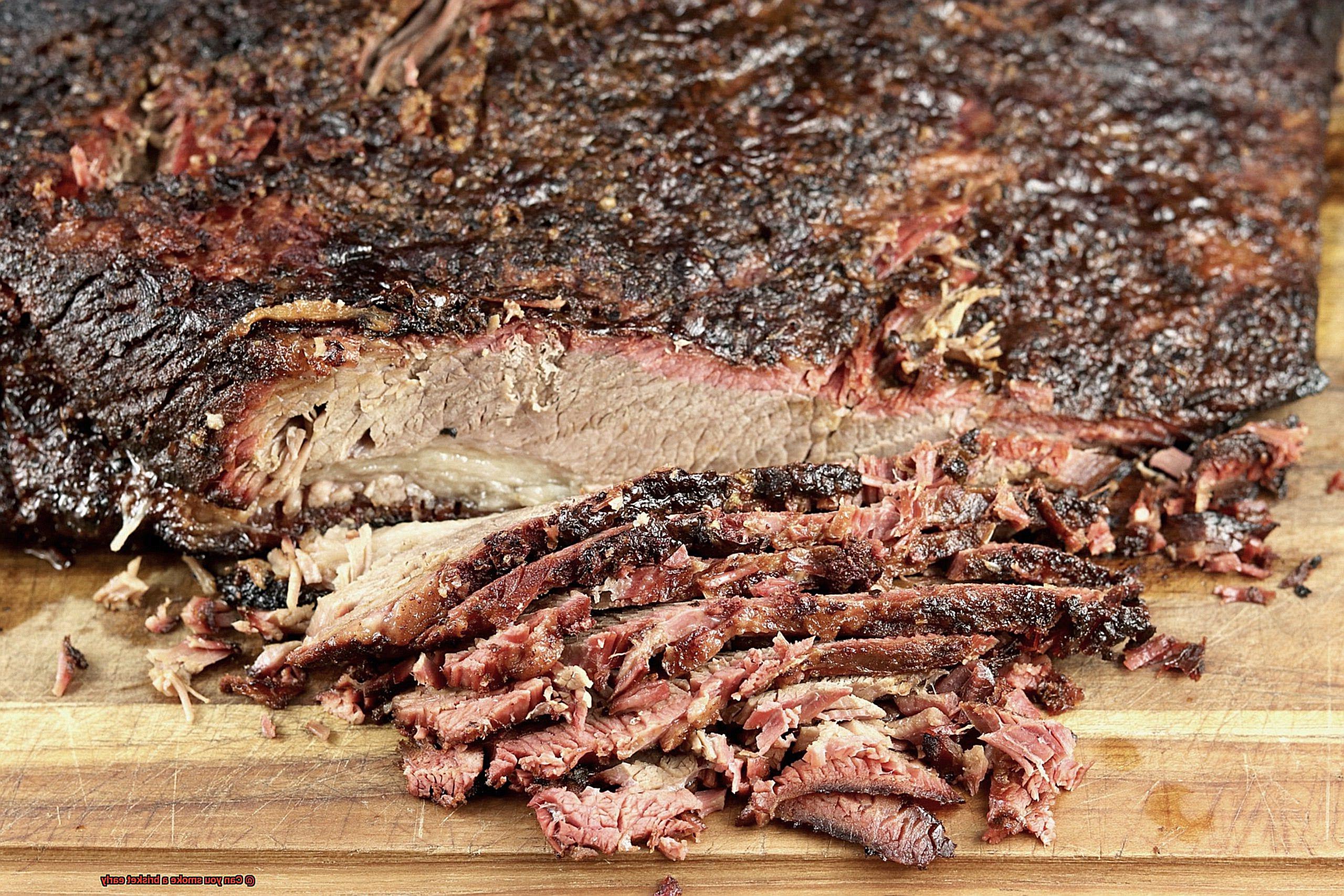
Maintaining a steady temperature is key when smoking a brisket early. This can be achieved by using a smoker with good temperature control or by monitoring the temperature of the smoker closely throughout the cooking process. Fluctuations in temperature can affect the texture and taste of your brisket.
Let Your Brisket Rest
After smoking your brisket early, let it rest for at least 30 minutes before slicing. This allows the juices to redistribute throughout the meat, resulting in a tender and juicy final product. Cover the brisket with foil or a towel to keep it warm while it rests.
JuwGL8JKPQQ” >
Conclusion
In summary, smoking a brisket early is not only possible, but it can also be a game-changer for those who want to plan ahead and save time. Although there are some potential downsides, such as changes in texture and flavor, the benefits of smoking a brisket early are numerous.
You have more control over the cooking process, allowing you to achieve maximum flavor infusion and flexibility with your cooking schedule.
To ensure that your early smoked brisket is a success, you need to take some necessary steps. First, plan ahead by choosing the right wood and properly preparing your brisket. Then maintain a steady temperature during the cooking process and let your brisket rest before slicing. Using sous-vide cooking or partially cooking in advance can also help you achieve great results.
When serving your smoked brisket, always use a meat thermometer to ensure that the internal temperature reaches at least 145°F. And if you have leftovers, don’t worry – simply reheat them using low heat with added moisture to keep your meat juicy and tender.

